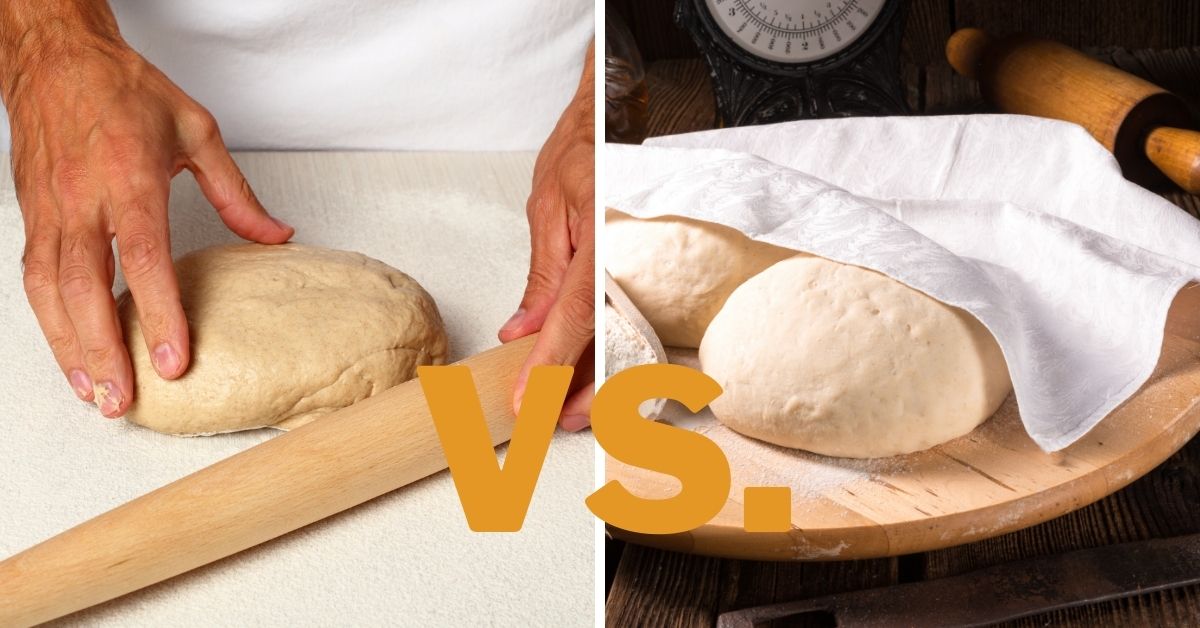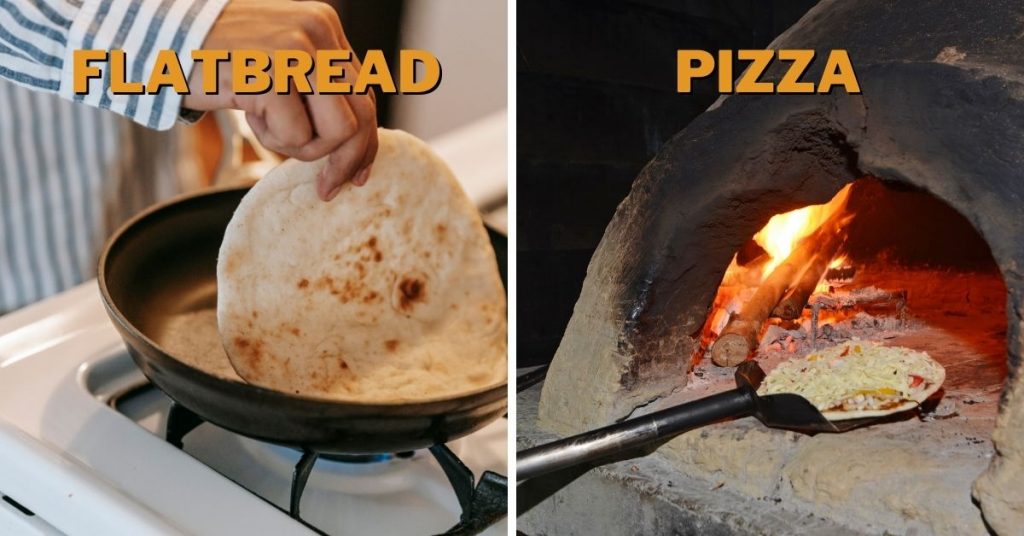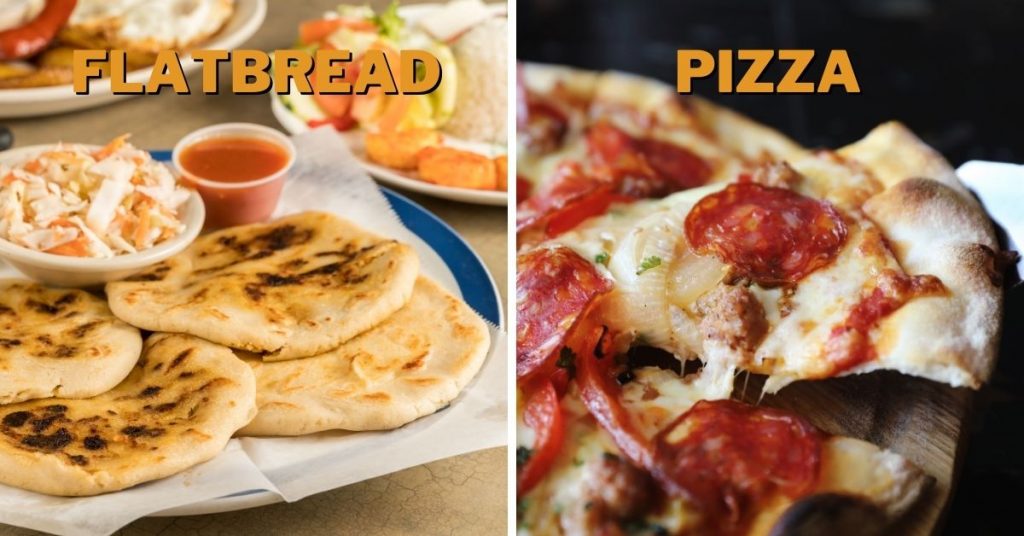Flatbread Vs. Pizza: Differences & Uses

The world of bread is diverse and sometimes a bit confusing. Various cuisines around the world make slight variations on the same basic formula and call it by different names. Two of the most popular archetypes are flatbread and pizza bread. So, are they the same thing?
Whereas traditional flatbread is any type of unleavened bread, pizza bread almost exclusively incorporates a leavening agent like yeast. As such, most flatbreads are thin and crisp while pizza is thicker and chewier. Basically, pizza is a variety of flatbread that uses leavening agents.
Flatbread encompasses a wide range of flat-surfaced bread, including pizza bread. But there are notable distinctions that separate pizza from most other varieties of flatbreads available worldwide. And, in this article, we are going to explore those distinctions.
Flatbread Vs. Pizza Dough: Differences
During this discussion between flatbreads and pizza, you are going to notice many overlapping qualities between the two. And that is because pizza started out as a flatbread that people gradually started putting different toppings on it.
Origin
Flatbread
Flatbreads are among the very first processed foods. Different human civilizations around the world, Egypt, Mesopotamia, ancient Asia, etc., independently developed their own versions of flatbreads. Given how convenient and versatile flatbreads are, especially in a subsistence economy, it is no surprise that early humans became fans of this method of bread production.
Pizza
While the modern version of pizza saw its inception in Naples, Italy in the 18th century, the roots of pizza can be traced back much further. Pizza-like food, where people topped flatbreads with various ingredients, was consumed by ancient Greeks, Romans, and Egyptians.
Much like the original flatbreads, pizza was also the food of the working class at the beginning. Essentially, people started to put various toppings on their flatbreads for a quick and cheap meal. After the invention of modern pizza in Italy, the popularity of this food spread throughout Europe and America, becoming one of the world’s most popular dishes.
Preparation
Flatbread
The basic steps in making flatbreads are pretty much similar in most cases, with one or two details varying here and there. First, a combination of flour (from wheat or other such cereals), water, salt, and occasionally some form of fat is mixed and kneaded. How much you knead the dough will determine the texture and toughness of the bread.
Then the dough is laid to rest for variable amounts of time, regardless of the incorporation of yeast. Then the dough is rolled on a flat to form a sheet of varying thickness. This is what flatbreads its trademark structure. Finally, the dough is baked in an oven, or tannur, or on a stovetop.
Pizza
As pizza is a type of flatbread, the production process is identical to most others of its kind. The key difference here is that you mix yeast inside the dough and let it rest for half an hour to a couple of hours. This gives the yeast time to release carbon dioxide and make the dough puff up.
Afterward, you roll the dough into the size and thickness you prefer. Depending on the thickness, you have a thin-crust pizza and a deep-dish pizza. Then you decorate the dough with various toppings such as cheese, tomato sauce, sliced vegetables, various spices, and herbs. Finally, you put it into the oven and bake it.
Pizza dough is always baked in an oven or in a brick bread oven.

Ingredients
The basic ingredients for both a traditional flatbread and pizza are mostly the same – flour, water, and some seasoning. The key difference is that flatbread dough can be made with a leavening agent or without one. A leavening agent is any substance that you add to the dough to make it rise when baking, with yeast being the most common and traditional.
Most flatbreads around the world such as tortilla, roti, naan, etc. do not incorporate yeast. Pizza dough, on the other hand, almost never goes without some. This is why pizza bread is softer and chewier than most flatbreads.
Uses
You can view a pizza as a complete dish while flatbreads are mostly a side dish or serve as the base for a bigger dish. As such, many people will eat pizza as their whole meal, with possibly some side dishes such as fried potatoes, soup, or a sauce. Alternatively, you can use leftover pizza dough to make dinner rolls, cinnamon rolls, donuts, calzones, pancakes, etc.
In contrast, most cuisines use flatbreads as a wrap, roll, or dipping material and as a part of a whole dish. Using various flatbreads as a means to wrap up things such as grilled meat, fried vegetables, etc. is a very common practice. For example, tortillas, roti, pita bread, and naan are all used in this capacity.
Variations
Different regions around the world came up with their own versions of flatbread independently of each other. As such, there are dozens of different flatbread recipes, each differing in terms of ingredients, preparation, cooking method etc. Some popular versions of flatbread around the world are listed below:
- Pita Bread – Eastern Mediterranean, Turkey
- Naan – Indian Subcontinent
- Roti – Indian Subcontinent
- Luchi – India and Bangladesh
- Fari – Scotland
- Focaccia – Italy
- Tandoor-nan – Central Asia
- Tortilla – Mexico and Central America
Since its inception, pizza has seen countless variations, some based on its crust, some on its toppings. There are thin-crust pizzas where the bread is similar to classical flatbread with a crispy texture. On the other side, you have Chicago-style pizzas, where the crust is very thick. Here are some of the popular variations of pizzas:
- Pizza Margherita – made with Tomatoes, mozzarella, and basil, it is the archetypal Neapolitan pizza.
- Pizza Marinara – Pizza with marinara sauce.
- Clam Pizza – a popular seafood pizza originating in England.
- Calzone – A type of folded pizza.
- Deep-fried pizza – pizza that is deep-fried in oil instead of baked in an oven.
- Detroit-Style pizza – a rectangular pizza with a deep crust.
- New York Pizza – a very large slice of pizza with a thin crust that you can easily fold.
Toppings
Flatbreads do not usually have toppings. They are frequently used as a wrap or roll to cover other ingredients such as meat, sauce, and vegetables. Most of these elements do not go with the bread when baking it. Rather the flatbread is baked separately and then used as a side dish.
When you put toppings on top of a flatbread, it becomes essentially a pizza. And the toppings for pizza can be pretty much anything you want it to be. You can put any type of meat on it, be it sliced, shredded, turned into a sausage or meatball. Due to fatty ingredients, pizza often turns out greasy. Similarly, you can top a pizza with all kinds of vegetables and cheese.

Nutrition
Traditional pizza bread and flatbread are mostly carbohydrate compounds. As such, they are full of calories. [1] So, people who are on a restrictive diet or looking to lose weight should consider minimizing bread intake. Of course, you can make the bread keto-friendly by replacing the flour with keto-friendly ingredients.
Apart from the bread itself, the actual nutritional value of a meal that consists of either pizza or flatbread depends on what you are serving them with.
| Feature | Pizza | Flatbread |
|---|---|---|
| Origin | Modern pizza originated in Italy. | Developed separately in different parts of the world. |
| Preparation | Almost always oven-baked | Oven-baked or cooked on a stovetop |
| Leavener | Almost always uses leaveners, mostly yeast | Can be leavened or unleavened. |
| Uses | Served as a complete dish | Served as a side dish, wrap, or dip. |
Can You Make Pizza Using Flatbread?
You can definitely make pizza out of flatbread as that is how the concept of a pizza originated. People started to supplement their flatbread with various toppings like oil, cheese, and herbs to boost the taste and make it a more complete meal. So, a pizza is essentially a leavened flatbread where you put various toppings and then bake them.
Is Flatbread Made from Pizza Dough?
A flatbread is any bread that has a flat surface, regardless of its thickness or puffiness. And you can do the same with pizza dough. But many other varieties of flatbread use a completely different dough than the ones used to make pizza. So, while you can make flatbread with pizza dough, it is just one type of dough for making flatbread.
Just roll it on a flat surface until you reach your desired thickness. Then top it off with your choice of meat, cheese, vegetables, and fruits. And then you bake it in an oven.
Are Flatbread and Pita the Same?
Pita is a group of flatbreads that originated in the Mediterranean and the Middle East. They are particularly prominent in Greek and Egyptian cuisine. Similar to pizza dough, pita bread often incorporates yeast as a leavening agent. So, while pita is a flatbread, not all flatbreads are similar to pita bread – it is that sort of concept.
Is Flatbread the Same as Wraps?
You can use flatbread as a wrap, but it’s not a wrap in essence. Flatbread is mostly considered as a side dish and not as a bread that holds the fillings together, like wrap is.
Wrap basically indicates a type of dish where you take a soft flatbread, put filling on top of it, and then roll it into a compact package. So, you “wrap” the filling with the flatbread. Various types of flatbreads are used for this purpose such as tortilla, pita bread, lavash, tandoor, etc.
To conclude, the history and evolution of flatbread and pizza are fascinating. What started out as cheap and convenient food for the working-class, both have become part and parcel of different cuisines around the world, enjoyed by people of all ages and classes.
